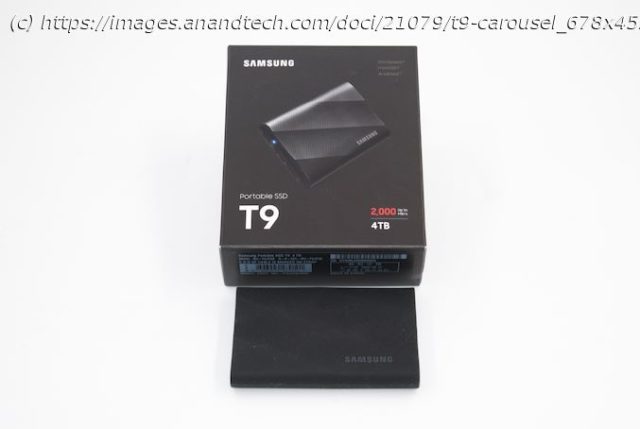Array
Samsung’s portable SSD lineup has enjoyed significant market success since the launch of the T1 back in 2015. Despite the release of the Thunderbolt-capable X5 PSSD in 2018, the company has been focusing primarily on the mainstream market with its T series drives.
The first set of PSSDs from Samsung incorporated a SATA SSD behind a USB 3.2 Gen 1 bridge chip. With the T5 in 2017, the company moved to a USB 3.2 Gen 2 bridge while retaining the SATA SSD. In the T7 Touch launched in 2020, the SATA component was replaced by a NVMe SSD and the USB 3.2 Gen 2 SATA bridge was replaced by a NVMe one. The T7 series was augmented with IP65-rated models (the T7 Shield) in 2022. Despite the same T7 moniker, the Shield’s use of newer NAND enabled improvements in both latency and power consumption.
Samsung is introducing the 2 GBps-class Portable SSD T9 today. Equipped with a USB 3.2 Gen 2×2 (20 Gbps) interface, the PSSD advertises double the performance of the T7 Shield. The company sent over the highest capacity version (4 TB) to put through our rigorous evaluation routine for direct-attached storage devices. The review below presents an in-depth investigation into the design and performance profile of the Samsung Portable SSD T9.Introduction and Product Impressions
External bus-powered storage devices have grown both in storage capacity as well as speeds over the last decade. Thanks to rapid advancements in flash technology (including the advent of 3D NAND and NVMe) as well as faster host interfaces (such as Thunderbolt and USB 3.x / USB4), we now have palm-sized flash-based storage devices capable of delivering 3GBps+ speeds. While those speeds can be achieved with Thunderbolt, mass-market devices have to rely on USB. Within the USB ecosystem, USB 3.2 Gen 2 (10 Gbps) is fast becoming the entry level for thumb drives and portable SSDs. USB 3.2 Gen 2×2 (20 Gbps) got off to a slow start, but recent computing platforms from both Intel and AMD have started to support it on the host side. The introduction of native USB 3.2 Gen 2×2 flash controllers such as the Phison U18 and Silicon Motion SM2320 has enabled PSSD vendors to bring low-cost power-efficient 20 Gbps external drives to the market.






